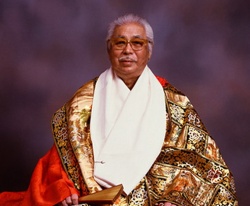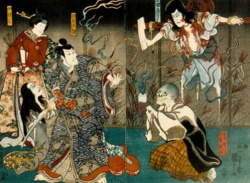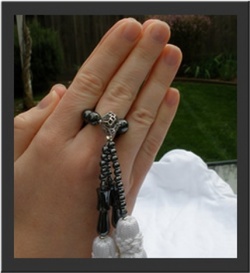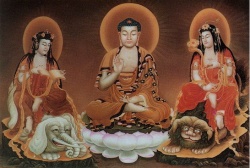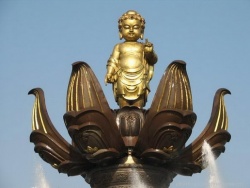Shinnyo-En
Shinnyo-en (真如苑) (meaning "Borderless Garden of Truth") is a Buddhist sangha open to lay practitioners and monks alike. Its principle teachings are based on the Mahayana Mahaparinirvana Sutra. The teachings also combine elements of traditional Theravada, Mahayana, and Vajrayana Buddhism with teachings and practices initiated by the founders of Shinnyo-en, Shinjō Itō (né Fumiaki Itō; March 28, 1906 – July 19, 1989) who trained in Shingon, and his wife Tomoji Itō (née Tomoji Uchida, May 9, 1912 – August 6, 1967), the first woman in the 1,000-year history of Daigo-ji monastery in Kyoto to receive the rank of daisōjō (大僧正) as a laywoman.
Today, Shinnyo-en has more than one million practitioners worldwide, and temples and training centers in several countries in Asia, Europe and the Americas. The temples are characterised by the statue of the reclining Buddha.
Central to Shinnyo-en is the belief, expressed in the Nirvana Sutra, that all beings possess a natural, unfettered purity that can respond creatively and compassionately to any situation in life.
The current head of Shinnyo-en is Her Holiness Keishu Shinsō Itō (b. 1942), who holds the rank of daisōjō, the highest rank in traditional Shingon Buddhism. On October 16, 2009 she accepted an invitation from Daigo-ji monastery to officiate at a ceremony marking Great Master Shobo Rigen's 1,100th memorial, becoming the first woman to officiate a service there.
History
Shinnyo-en was established in 1936 by Shinjō Itō (aka: Fumiaki Ito) and his wife Tomoji Ito in the Tokyo suburb of Tachikawa. Formally recognized in 1948 after the Religious Cooperation Law was issued (the law became effective on December 28, 1945), 'Makoto kyodan,' having Shincho-ji Temple as its sohonzan, was established (Shinjo ITO, chief abbot, 1948).The organization was originally named Risshōkaku. Shinojo and Tomoji came from the same village and were second cousins of each other. In December 1935, Shinjō Itō and Tomoji Itō enshrined an image of Mahavairochana Achala (believed to have been sculpted by the renowned Buddhist sculptor, Unkei) and they began a 30-day period of winter austerities in early 1936. In 1950, Shinjo was arrested on an accusation of his former private pupil actual culpability remains a mystery. Tomoji cultivated her spiritual faculty (Jpn. "reino") on February 4, inheriting it from her aunt. From that time, Tomoji and Shinjō began a new life together entirely devoted to encouraging people's spiritual growth. Shinjō Itō became a Great Master Acharya in the Shingon tradition of Japanese Buddhism. The principal Sutra on which the Shinnyo teachings are based is Buddha's Mahaparinirvana Sutra. The teachings also combine elements of traditional Theravadan, Mahayana and Vajraya Buddhism also with Japanese cultural influence(notably; a fusion of Buddhism with Shinto or ancestor worship) and other dogmatic theology, teachings, practices and rituals initiated by the founder of Shinnyo en, Shinjo Ito.
Organizational structure
The leadership is steered as a dynastic family legacy; two Sisters (Tomoji and Shinjō) daughters of the civilian/zaibatsu aircraft engineer, turned Shingon (Fire) priest founder and his wife as high priestesses. Another sister rejects and has no role in the new religion. Two other siblings however that perished early on as children, while the founder and his wife were promoting and perfecting the rites and esoteric narrative basis for the new religion are now deified in the teaching and exist as statues to be prayed to by followers.
Renosha, (Jpn. reinōsha), are members with higher rank who have trained and met certain Sheshin training criteria and tenure. They are spiritual leaders capable of performing so-called Shessin training and rituals of meditation. A trance-like state is entered into by the Renosha and then guidance and fortune telling to the follower with specific questions written, submitted and paid for beforehand are then focused on. Advice from Renosha is delivered and spoken while in trance or communication with whatever spiritual realm in alternate voices (pitch, tone cadence) or even foreign tongues to followers who have paid the fees and requested it. The advice typically will be personalized in some way and revolves around and is frequently attributed to various character flaws of the follower or ancestral discomfort manifesting itself in a karmic justice manner, for which suggestions to; deepen involvement, more attendance, prayer, meditation and service work continually to mystically absolv(Karmic exorcism) the attributable bad luck karma are then proffered by the Reynosha to the followers. Suggested repetition of this Shessin ritual process at intervals is ostensibly used then as ongoing benchmarking of progress on the psyche, ego, or ancestral haunting issues raised by either or both the follower and Renosha subsequently; resolution of issues raised may or may not occur or may simply be sublimated or also superseded and replaced by new issues of concern.
Lay people and followers advance in hierarchal rank also by both tenure and by doing certain volunteer activities for the Religion as may be prescribed and by encouraged. For example; advancement is also achieved by meeting certain esoteric quotas of evangelical recruiting and escorting of new potential members by bringing (to temples or meetings) and exposing others to the teaching. The only primary publicly (non-esoteric) disseminated documentation about organizational structure follows this basic explanation: the basic organizational unit of the Shinnyo-en sangha is the “lineage” (Jpn. suji), which consists of a number of members linked to a “lineage parent” (Jpn. sujioya). Practitioners usually gather at the temple and training centre for prayer, meditation and training, and, if they so wish, also at home meetings. The sangha as a whole encourages and participates in volunteer activities in the spirit of Buddhist practice.
Social action
Shinnyo-en believes an individual's action can contribute to creating a harmonious society. Working towards this goal, the organization engages in interfaith dialogue, environmental activities, and disaster relief. Shinnyo-en also supports organizations such as Médecins sans Frontières (Doctors Without Borders), the Red Cross Society, and the World Wildlife Fund. Their cultural projects include the reconstruction of ancient musical instruments, support for the Kiyosato Museum of Photographic Arts, the excavation of ruins at Angkor Wat in Cambodia, and collecting Cambodian oral folk tales for a children’s book project. (See also Press report of The Indian National Trust for Art & Cultural Heritage(INTACH)) Shinnyoen, in 2001 planned to build nonreligious facilities — including parks and sports and cultural centers — on part of the 1-million-sq.-meter plot between Musashimurayama and Tachikawa in western Tokyo that it planned to purchase from Nissan. “We are hoping to make space (on the land the group plans to purchase) accessible and spiritually appealing to the public,” said Minoru Shitara, a Shinnyo En spokesman. During 2005-2007, Shinnyo-en supported and cooperated with the Jewish-Palestinian Living Room Dialogue to enact the Palestinian-Jewish Family Peacemakers Camp—Oseh Shalom - Sanea al-Salam at Camp Tawonga that brought hundreds of Muslim, Christian, and Jewish youth and adults into relationship.
Shinnyo-en practice
Shinnyo-en practices a form of meditation called sesshin training. Sesshin (the word is composed of the two Chinese characters, “touch” and “heart”) is meditation with the addition of guidance or insights given to trainees by specially trained “spiritual guides” (Jpn. reinōsha).
Through mindfulness and seated meditation, practitioners reflect on themselves and resolve to practice harmony, gratitude, kindness, and acceptance. The school teaches that one realizes his or her true potential by acting with compassion and concern for others. Therefore, practitioners are encouraged to cultivate mindfulness and self-reflection, and to apply in daily life the insights gained in seated meditation.
Shinnyo-en practitioners in pursuing the Path to Nirvana vow to abide by the Five Precepts (Pali: pañca-sīlāni) and follow the Eightfold Path. By learning to identify with others (or "place oneself in the shoes of another"), practitioners aim to cultivate the virtues of a bodhisattva.
Shinnyo-en Buddhist ceremonies
Traditional ceremonies, derived from Shingon Buddhism—many of which can be traced back to ancient Vedic and Hindu ceremonies—are an important aspect of Shinnyo Buddhist practice. Rituals are used as means to purify the mind, awaken compassion, or to express gratitude for the chance to develop oneself and practice the Buddhist teachings. Prayers for ancestors and departed souls, such as the Lantern Floating ceremony, and O-bon (Sanskrit: Ullambana), are believed to also help cultivate kindness and compassion within practitioners. Traditional fire ceremonies such as homa are performed to help practitioners overcome obstacles that hinder their spiritual progress and liberation. (See also Saisho Goma ceremony and Lantern Floating ceremony).
Shinnyo-en and the arts
Shinnyo-en believes art is a way to communicate universal, spiritual truth. Shinnyo-en sponsors many international cultural events to share their aesthetic philosophy. In addition, Shinnyo-en has staged several concerts showcasing the drumming of the Shinnyo-en Taiko Drumming Ensemble.
